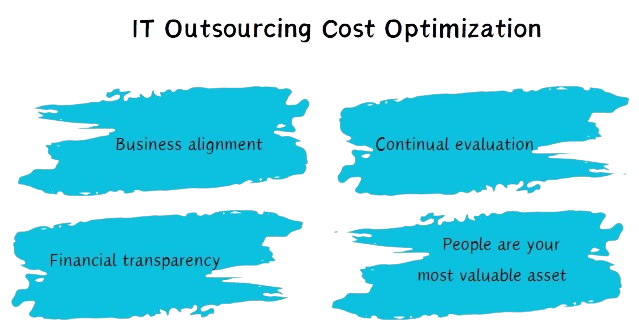IT outsourcing plays a pivotal role to help companies stay competitive and agile. This article describes critical aspects of managing IT outsourcing costs. Cost dynamics makes businesses optimize their strategies. It brings financial efficiency and operational excellence in the IT endeavors. Join us as we check out the idea of IT outsourcing costs and unlock strategies for sustainable success.

If you want to learn more about how to effectively work with outsourced teams, visit our blog where we cover this topic in detail: outsourced development team.
What are Outsourcing Costs?
Outsourcing costs are the expenses linked with hiring external companies to handle specific tasks or functions. They cover service fees, management overhead, and additional charges. Clear take in of these costs helps businesses allocate resources efficiently. That’s what makes everything grow strategically.
With understanding and managing outsourcing costs, companies can make smart decisions. They minimize financial risks, and get the most out of their partnerships. We explore outsourcing prices, and provide insights and tips for effective management in projects.
IT Outsourcing Cost Savings
Outsourcing IT saves money for businesses. It’s cheaper to hire outside help than to do everything in-house. When you do it, you don’t need to spend as much on things like training or buying equipment. Plus, you can adjust how much you use based on what you need. Outsourcing cost savings statistics helps with budgeting because you can agree on a fixed price or pay as you go.
What IT Services Can Be Outsourced?
You can outsource a variety of IT services to external providers. This includes:
- software development
- technical support
- network management
- cybersecurity
- cloud computing.
The cost estimating services go to specialized companies. They have the expertise and resources to handle them efficiently. By outsourcing these tasks, businesses can focus on their core operations. They benefit from the expertise and cost savings offered by external service providers.
The Benefits of IT Outsourcing in 2024
In 2024, IT outsourcing offers several benefits to businesses. It provides access to specialized expertise and resources. Companies tap into the latest technologies without heavy investments. Outsourcing also brings scalability. Businesses adjust resources as needed.
Additionally, it reduces operational costs by eliminating the need for in-house infrastructure and staff. With it companies can stay competitive and agile. They focus on the core objectives and leverage external support for their IT needs.

How Much Does IT Outsourcing Cost?
Pricing varies based on factors like the service needed. They see how hard the project is, and where the provider is located. On average, outsourcing can be cheaper than doing everything in-house. The price typically ranges from $30 to $150 per hour. Some jobs might cost more if they’re more specialized. Also, companies often agree on a fixed price or pay a set amount for ongoing support.
Types IT Outsourcing Models
IT outsourcing comes in different models to suit varying needs. These include fully outsourcing IT. There, an external provider handles all IT tasks. Also, co-management exists, where the provider works alongside in-house IT teams. Other models include direct outsourcing. It means that specific tasks are delegated to external specialists, and break-fix IT. The support is provided on an as-needed basis. Each model offers unique offshore outsourcing pros and cons, so businesses choose the one that best fits their requirements.
Factors Affecting Help Desk Costs
Several factors influence help desk costs. It includes the level of support needed, the complexity of issues handled, and the size of the user base. Additionally, the availability of self-service options and automation tools can impact costs. It reduces the need for human intervention. The location of the help desk team and the expertise of support staff also play a role. By considering these factors, businesses can better estimate and manage their help desk expenses.
IT Outsourcing Market Rates
The cost of outsourcing IT changes based on things like the service you need and where the provider is. Prices usually go from $30 to $150 per hour. Places like Eastern Europe and Asia often have lower rates. Some companies agree on a fixed price or pay a set amount for regular support. These are common in the IT market.
IT Outsourcing Best Practices
IT outsourcing demands a careful blend of strategy and execution. Maximize the potential benefits and minimize risks, adhere to best practices. Let us outline the fundamental principles that drive successful IT initiatives.
- Define clear goals and requirements.
- Foster open and regular communication.
- Establish transparent expectations and performance metrics.
- Prioritize security and data protection.
- Cultivate a collaborative partnership.
- Continuously evaluate and adapt strategies for ongoing success.
How to Choose The Costs of Common IT Outsourcing Services
It takes careful consideration of various factors for optimal outcomes within budgets. See the insights into common IT services to manage costs well.
- Assess your specific needs and objectives for outsourcing.
- Research and compare service providers based on expertise, reputation, and pricing.
- Determine the scope and complexity of the required services.
- Obtain detailed price estimates and negotiate pricing terms.
- Consider long-term value and ROI when evaluating costs.
- Implement strategies to monitor and control expenses over time.

Ways To Calculate Outsourcing Cost
When figuring out outsourcing costs, you need to look at a bunch of things to make sure you’re budgeting and assigning resources correctly. First, identify exactly what services you need and how much they price. Then, think about any extra expenses like the outsourcing fee or ongoing maintenance. Also, consider how long you’ll be doing it for for and what the contract says. Finally, use tools or talk to providers to come up with a budget that fits your financial goals.
Cost Table Comparison
Here’s a simple price table comparison for the IT outsourcing service providers:
| Service Provider | Service Offered | Monthly Cost (USD) | Setup Fee (USD) | Hourly Rate (USD) |
| TechSolutions Inc. | IT Support & Maintenance | $1,500 | $500 | $50 |
| ITPros Outsourcing | Software Development | $3,000 | $1,000 | $80 |
| CloudTech Solutions | Cloud Infrastructure | $2,500 | $750 | $60 |
This table provides a comparison of the monthly costs, setup fees, and hourly outsourcing rates for three different IT outsourcing service providers. Based on this data, businesses can make informed decisions based on their budget and requirements.
Outsourced Software Development Comparison by Regions
Here’s a comparison of software development costs across different regions:
| Region | Average Hourly Rate (USD) | Level of Expertise | Cultural Compatibility | Time Zone Compatibility |
| North America | $100 – $150 | High | High | Moderate to High |
| Western Europe | $80 – $120 | High | Moderate to High | Moderate to High |
| Eastern Europe | $30 – $70 | High | Moderate to High | Moderate to High |
| Asia | $20 – $50 | Varies | Moderate | Moderate to Low |
| Latin America | $30 – $70 | Varies | Moderate | Moderate |
This comparison provides an overview of the average hourly rates. See the outsourced software development across different regions. Check out the considerations such as level of expertise, cultural compatibility, and time zone. Businesses can use this information to make informed decisions. They depend on their budget, project requirements, and preferences.
IT Outsourcing Market Rates
Here’s a comparison of IT outsourcing market rates across different regions:
| Region | Average Hourly Rate (USD) |
| North America | $80 – $150 |
| Western Europe | $60 – $120 |
| Eastern Europe | $30 – $80 |
| Asia | $20 – $60 |
| Latin America | $30 – $70 |
These rates reflect the average hourly rates for IT outsourcing services in various regions. Factors such as the level of expertise, project complexity, and market demand may influence actual rates. Businesses can use this information to evaluate cost-effective outsourcing options based on their specific needs and budget constraints.
Staffing Capability
Staffing capability means having enough people with the right skills and keeping them happy and productive. It involves hiring, training, and managing employees well. When a company has good staffing capability, it can meet its goals effectively. Thanks to a focus on staffing capability, businesses get the right team to succeed in the long run.
How to Choose an IT Outsourcing Destination
Picking an IT outsourcing spot means looking at a few things to find the best match for your needs. First, check if there’s enough skilled talent and if it’s cost-effective. Consider things like political stability and rules in the area. Think about language and cultural similarities, plus time zone differences for easy teamwork. Also, see how well-known and reliable companies are there. By considering all these, you can find the right place for your outsourcing work.
Conclusion
Managing IT outsourcing costs requires smart planning. Understand what you need, compare providers, and negotiate terms. By being clear and working together, businesses can save money and stay competitive. Consider factors like location and staffing to make the right choices. In the end, it’s about being smart with resources and aiming for success.
FAQ
What are the typical costs associated with IT outsourcing?
IT outsourcing costs vary depending on factors like the service required and provider location. On average, hourly rates range from $30 to $150. Setup fees and monthly costs also vary, typically falling between $500 to $3,000.
How can businesses guarantee they choose the right IT outsourcing service provider?
To select the right provider, businesses should thoroughly research and compare based on expertise, reputation, and pricing. It’s crucial to assess the scope and complexity of required services, obtain detailed cost estimates, and negotiate pricing terms to ensure alignment with long-term goals and budget.
What factors should businesses consider when determining whether to outsource IT services?
Businesses should assess their specific needs, objectives, and budget constraints before deciding to outsource IT services. Key considerations include the complexity of tasks, availability of internal resources, and the potential for cost savings. Additionally, evaluating factors like service quality, security measures, and scalability is essential for successful partnerships.
How can businesses manage and control outsourcing expenses over time?
To manage expenses, businesses should implement strategies such as monitoring service usage, optimizing resource allocation, and periodically reassessing provider agreements. Establish clear performance metrics, foster open communication, and prioritize long-term value over short-term cost savings.